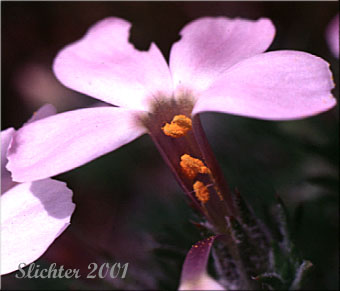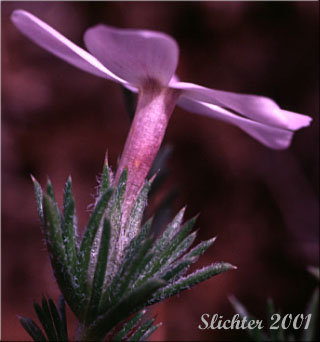 Photo
at right of Phlox hoodii from the Dalles Mt, Columbia River Gorge.........4/22/2001.
Note the stamens attached at varying levels of the tube.
Photo
at right of Phlox hoodii from the Dalles Mt, Columbia River Gorge.........4/22/2001.
Note the stamens attached at varying levels of the tube.
Hood's Phlox is a pretty, compact, mat or low cushion forming wildflower. The leaves are firm and pungent, and are narrowly linear. Most leaves range from 4 to 10 mm long and about 0.5 to 1 mm wide. The leaves of Hood's phlox tend to be stiffer and generally shorter than those of spreading phlox (Phlox diffusa).
The beautiful flowers are solitary, sessile, and at the tips of the stems. The corolla is white, pink, or a light blue. The tube ranges in length from 4 to 10 mm long, with the lobes being 4 to 7 mm long. The membranes between the ribs of the calyx tube are flat and often obscured by the hairs there. The style is 2-5 mm long. Four of the anthers are near the mouth of the tube, while the fifth is below the others. It is positioned above the tip of the style.
Spreading Phlox: Phlox diffusa - A low phlox that forms compact to spreadingcushions. The leaves tend to be wider and blunter, and feel generally fairly soft to the touch ("less ouchy" when you kneel on them or put your hand on them!). Generally found in the western and middle Columbia River Gorge to the west of the Little White Salmon River.
Hood's Phlox is a wildflower of dry open places. It is commonly found with sagebrush. It is found from the hills of the lowlands to moderate elevations in the mountains.
Hood's Phlox is a widespread phlox. It is found from Alaska south through the Yukon, and along the east side of the Rockies into Alberta and Saskatchewan to northern Colorado and western Nebraska. It passes westward of the Rockies through Wyoming to southern Idaho, northern Utah, and as far west as the eastern base of the Cascade Range, into central Washington and south through central Oregon to northeastern California.
In the Columbia River Gorge, it may be found between the elevations of 2100'-3000' along the crest of the Columbia Hills north of the Dallesport, WA.
Very early blooming Hood's phlox as seen high in the Columbia Hills (next to a snow drift).........February 4, 2009.
